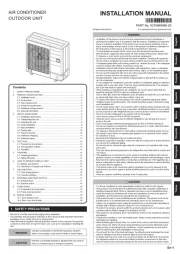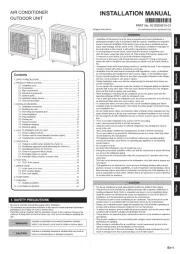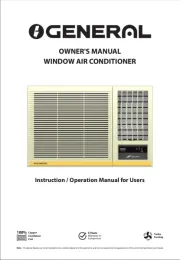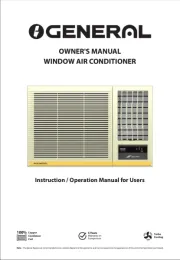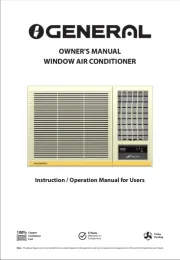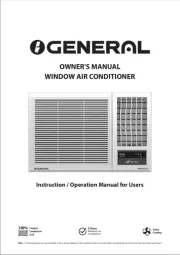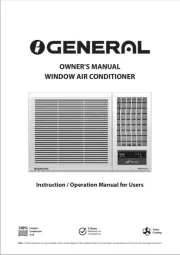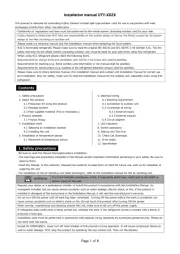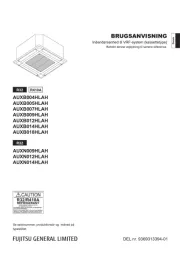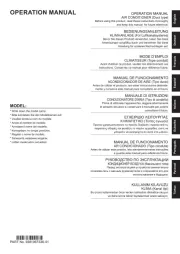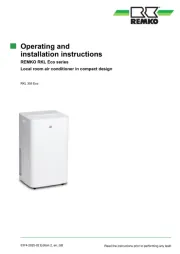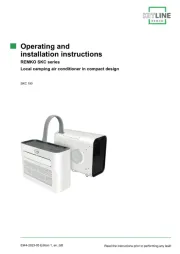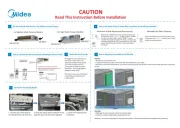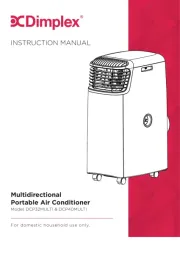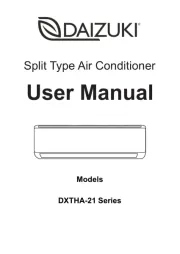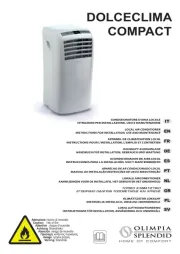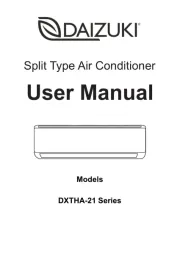En-1
1. SAFETY PRECAUTIONS
• Read carefully all of safety information written in this manual before you install or use the
air conditioner.
• The warnings and precautions indicated in this manual contain important information
pertaining to your safety. Be sure to observe them.
• Hand this manual, together with the operation manual, to the customer. Request the
customer to keep them on hand for future use, such as for relocating or repairing the
unit.
WARNING Indicates a potentially or imminently hazardous situation which, if
not avoided, could result in death or serious injury.
CAUTION
Indicates a potentially hazardous situation that may result in minor or
moderate injury or damage to property.
WARNING
To avoid getting an electric shock, never touch the electrical components soon after the
power supply has been turned off . After turning off the power, always wait 10 minutes or
more before you touch the electrical components..
Installation of this product must be done by experienced service technicians or
professional installers only in accordance with this manual. Installation by non-
professional or improper installation of the product might cause serious accidents such
as injury, water leakage, electric shock, or fi re. If the product is installed in disregard of
the instructions in this manual, it will void the manufacturer’s warranty.
Do not turn on the power until all work has been completed. Turning on the power
before the work is completed can cause serious accidents such as an electric shock or
a fi re.
If refrigerant leaks when you are working, ventilate the area. If the leaking refrigerant is
exposed to a direct fl ame, it may produce a toxic gas.
The air conditioner must be installed accordance with electrical installation standard for
Thailand of The Engineering Institute of Thailand Under H.M. The King’s Patronage.
Do not use this equipment with air or any other unspecifi ed refrigerant in the refrigerant
lines. Excess pressure can cause a rupture.
During installation, make sure that the refrigerant pipe is attached fi rmly before you
run the compressor. Do not operate the compressor under the condition of refrigerant
piping not attached properly with 2-way or 3-way valve open. This may cause abnormal
pressure in the refrigeration cycle that leads to rupture and even injury.
When installing or relocating the air conditioner, do not mix gases other than the
specifi ed refrigerant (R32) to enter the refrigerant cycle.
If air or other gas enters the refrigerant cycle, the pressure inside the cycle will rise to
an abnormally high value and cause rupture, injury, etc.
For appropriate working of the air conditioner, install it as written in this manual.
To connect indoor unit and outdoor unit, or indoor unit and branch box, use air
conditioner piping and cables available through your local distributor. This manual
describes proper connections using such installation set.
Do not modify power cable, use extension cable or branch wiring. Improper use may
cause electric shock or fi re by poor connection, insuffi cient insulation or over current.
Do not purge the air with refrigerants but use a vacuum pump to vacuum the
installation.
There is no extra refrigerant in the outdoor unit for air purging.
Do not use means to accelerate the defrosting process or to clean, other than those
recommended by the manufacturer.
The appliance shall be stored in a room without continuously operating ignition sources
(for example: open fl ames, an operating gas appliance or an operating electric heater.
Do not pierce or burn.
Be aware that refrigerants may not contain an odour.
Using the same vacuum pump for diff erent refrigerants may damage the vacuum pump
or the unit.
Use a clean gauge manifold, vacuum pump and charging hose for R32 or R410A
exclusively.
WARNING
Do not modify this unit, such as opening a hole in the cabinet.
During the pump-down operation, make sure that the compressor is turned off before
you remove the refrigerant piping.
Do not remove the connection pipe while the compressor is in operation with 2 way or 3
way valve open. This may cause abnormal pressure in the refrigeration cycle that leads
to rupture and even injury.
CAUTION
This unit must be installed by qualifi ed personnel with a capacity certifi cation of handling
refrigerant fl uids. Refer to regulation and laws in use on installation place.
Install the unit by following local codes and regulations in force at the place of
installation, and the instructions provided by the manufacturer.
This unit is part of a set constituting an air conditioner. The unit must not be installed
alone or be installed with non-authorized device by the manufacturer.
When installing pipes shorter than 3 m, sound of the outdoor unit will be transferred to
the indoor unit, which will cause large operating sound or some abnormal sound.
To protect the persons, earth( ground) the unit correctly, and use the power cable
combined with an Earth Leakage Circuit Breaker (ELCB).
The units are not explosion proof, and therefore should not be installed in explosive
atmosphere.
This unit contains no user-serviceable parts. Always consult experienced service
technicians for repairing.
When moving or relocating the air conditioner, consult experienced service technicians
for disconnection and reinstallation of the unit.
Children should be monitored to ensure they do not play with the device.
This appliance is not intended for use by persons (including children) with reduced
physical, sensory or mental capabilities, or lack of experience and knowledge, unless
they have been given supervision or instruction concerning use of the appliance by a
person responsible for their safety. Children should be supervised to ensure that they do
not play with the appliance.
Do not touch the aluminum fi ns of heat exchanger built-in the indoor or outdoor unit to
avoid personal injury when you install or maintain the unit.
Do not place any other electrical products or household belongings under indoor unit or
outdoor unit. Condensation dripping from the unit might get them wet, and may cause
damage or malfunction of your property.
Precautions for using R32 refrigerant
The basic installation work procedures are the same as conventional refrigerant (R410A,
R22) models.
However, pay careful attention to the following points:
WARNING
Since the working pressure is 1.6 times higher than that of refrigerant R22 models,
some of the piping and installation and service tools are special. (See “2.1. Special
tools for R32 (R410A)”.)
Especially, when replacing a refrigerant R22 model with a new refrigerant R32 model,
always replace the conventional piping and fl are nuts with the R32 and R410A piping
and fl are nuts on the outdoor unit side.
For R32 and R410A, the same fl are nut on the outdoor unit side and pipe can be used.
Models that use refrigerant R32 and R410A have a diff erent charging port thread
diameter to prevent erroneous charging with refrigerant R22 and for safety. Therefore,
check beforehand. [The charging port thread diameter for R32 and R410A is 1/2 inch.]
Be more careful than R22 so that foreign matter (oil, water, etc.) does not enter the
piping.
Also, when storing the piping, securely seal the opening by pinching, taping, etc.
(Handling of R32 is similar to R410A.)
AIR CONDITIONER
Wall Mounted Type
INSTALLATION MANUAL
For authorized service personnel only.
PART No.9320394080-01
Contents
1. SAFETY PRECAUTIONS .......................................................................................... 1
2. ABOUT THIS PRODUCT........................................................................................... 3
3. SELECTING THE MOUNTING POSITION ............................................................... 4
4. INSTALLATION DIAGRAM ........................................................................................ 5
5. INDOOR UNIT INSTALLATION ................................................................................ 5
6. OUTDOOR UNIT INSTALLATION ............................................................................ 6
7. FINISHING................................................................................................................. 7
8. TEST RUN ................................................................................................................. 7
9. CUSTOMER GUIDANCE .......................................................................................... 8
10. FRONT PANEL REMOVAL AND INSTALLATION ..................................................... 8
11. PUMP DOWN OPERATION (FORCED COOLING OPERATION) ............................ 8
12. SELECTING THE REMOTE CONTROLLER CUSTOM CODE ................................ 8
13. FUNCTION SETTING................................................................................................ 8
14. ERROR CODES ........................................................................................................ 9
ไทย English
